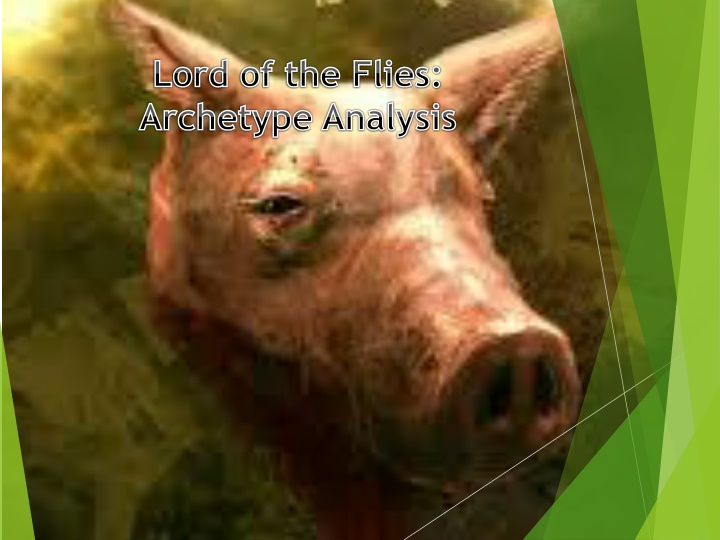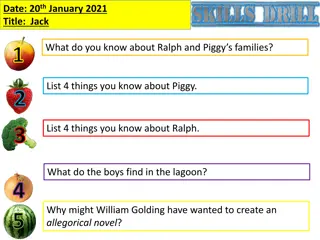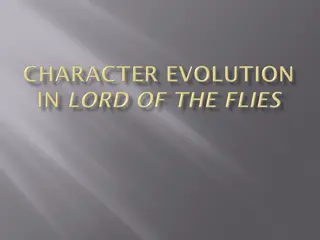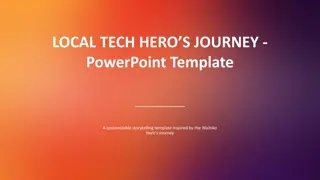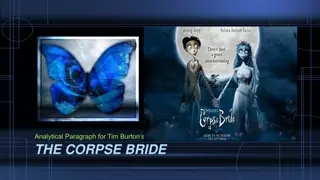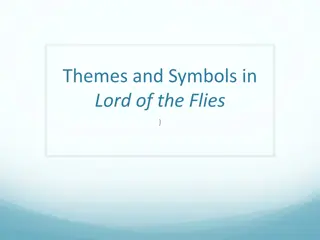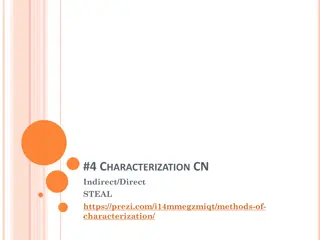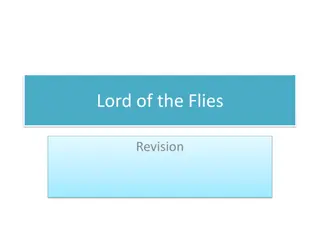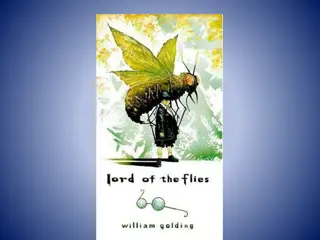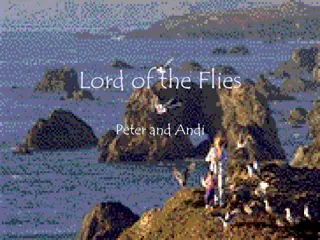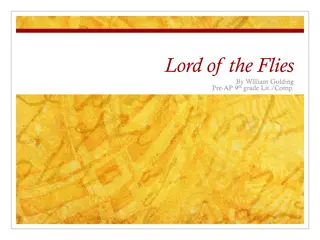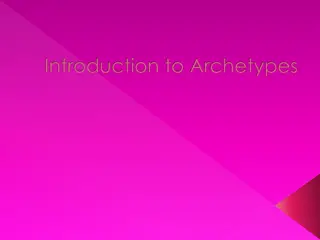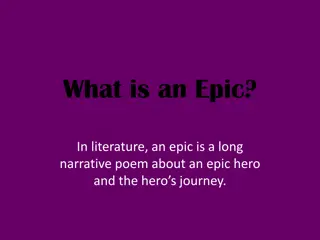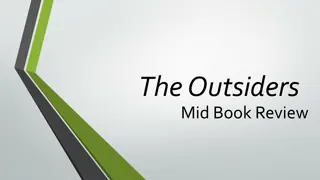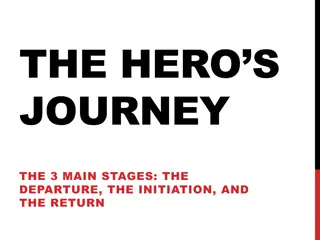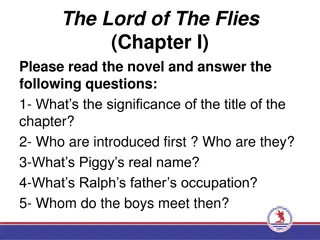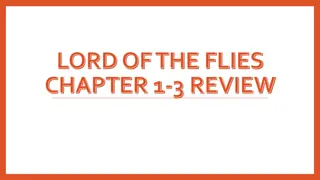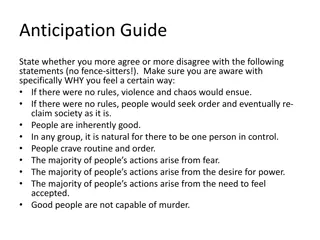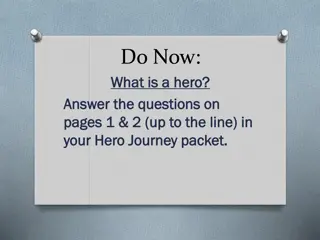Analysis of Archetypes in "Lord of the Flies" - A Hero's Journey
In "Lord of the Flies," the story unfolds as a group of schoolboys face challenges after a plane crash on an uninhabited island. As they transition from the Ordinary World to facing the Call to Adventure, the heroes must confront their inner flaws and fears. This archetypal analysis delves into the stages of the Hero's Journey and how the characters' actions shape their destiny, ultimately leading to a deeper understanding of human nature and civilization.
Download Presentation

Please find below an Image/Link to download the presentation.
The content on the website is provided AS IS for your information and personal use only. It may not be sold, licensed, or shared on other websites without obtaining consent from the author.If you encounter any issues during the download, it is possible that the publisher has removed the file from their server.
You are allowed to download the files provided on this website for personal or commercial use, subject to the condition that they are used lawfully. All files are the property of their respective owners.
The content on the website is provided AS IS for your information and personal use only. It may not be sold, licensed, or shared on other websites without obtaining consent from the author.
E N D
Presentation Transcript
Lord of the Flies: Archetype Analysis
Lord of the Flies: A Hero s Journey? A plane crashes into an uninhabited island, stranding a group of schoolboys. All the adults are dead. All the rules are gone. They are finally free to do whatever they want. At first this means small challenges to the rules of order and civilization. However, as they get braver their fun turns to terror.
A Heros Journey: Analysis of The Lord of the Flies Chris Vogler has 12 stages of plot patterns. He clearly states that the Hero s Journey is a guide, not a rigid formula. Some steps can be out of order. Or some steps can be missing entirely.
Ordinary World Most Hero s Journeys start in the Ordinary World. This setting usually allows us to get to know the Hero and identify with him Let s us see the flaws and special attributes Is important to set up a contrast with the special world.
Ordinary World: LOTF Although most Hero s Journeys have a bit of time in the Ordinary World to see the Hero functioning in his home setting, we only have a a brief glimpse of this physical setting through the plane. Plane was taking the students home from boarding school This Hero s personality is established early on in the film and novel through his actions toward Piggy and the others. He is depicted in a more positive light in the film. Why? From the start of the novel he is shown to be charismatic and well liked, but also rude and a bit of a bully. He wants to establish order and rules through the building of shelters and creation of a fire.
Call to Adventure Disrupts the comfort of the Ordinary World Presents a challenge Gets the story and excitement going Delivered by the Herald: letter, riddle weather, arrival of the villain, death, abduction, etc) Consequences for refusal
Call to Adventure: LOTF Survive the plane crash Herald was the plane crashing due to being attacked (8). Can t refuse; consequence would be death. Another call to adventure is when Ralph is elected leader (22-23).
Refusal of the Call Hero refuses the call or is reluctant Insecurities and fears of the Hero are outlined Risks of the journey are outlined
Refusal of the Call Swimming in the pond. Not listening to Piggy. Betraying Piggy s trust: He s not Fatty [ ] his real name s Piggy (21). Not accurate in film.
Meeting with the Mentor Meets a mentor Gives Hero confidence, knowledge, and insight. Is a profoundly knowledgeable character Gives wisdom Reassures the Hero
Meeting with the Mentor: LOTF Piggy fulfills this role Wise Tries to provide guidance Promotes civilization Piggy shouted again. Which is better to have rules and agree, or to hunt and kill? (180) I expect we ll want to know all their names [ ] and make a list. We ought to have a meeting. (11)
Crossing the Threshold Hero commits to the journey Hero confronts a special event Commits to entering the new world No turning back
Crossing the Threshold Possibilities: Accepting his role as leader When Jack splits the group When the boy with the birthmark dies in the fire (not in film) That little un [ ] with the mark on his face, I don t see him. Where is he now? (46).
Tests, Allies And Enemies Hero faces tests and throughout the process figures out allies and enemies Learns the rules of the Special World Each test prepares Hero for the Ordeal Allies can help guide the Hero Enemies reflect the Hero s dark side
Tests, Allies And Enemies Allies: Piggy and Simon Sometimes Sam n Eric Enemies: Jack, Roger, The Lord of the Flies , their own fear, anarchy Tests: Building and maintaining the fire Maintaining order and civilization Identifying and facing the beast within
Approach the Inmost Cave Hero makes preparations Leads to the Ordeal Often involves planning: maps, reconnaissance, picking off the enemy Hero faces biggest fear Consists of reorganization and the rekindling of morale
Approach the Inmost Cave After Simon s death, Ralph and Piggy retreat back to the beach. They are alone. Everyone has abandoned them. They try to come to terms with Simon s murder (156). They decide to confront the others. Ralph and Piggy are the only ones to acknowledge the deed
Supreme Ordeal Central life-or-death crisis Confronts his greatest fear, most difficult challenge, death On the brink of failure Climax Can witness the death of an ally Often faces the villain
Supreme Ordeal: LOTF Piggy is killed with a rock Ralph is forced to flee He is chased and his life is threatened Roger sharpens a stick at both ends
The Reward Hero survives death Overcomes greatest fear Earns the reward: A magical or special item Greater insight Knowledge Their life A moment of celebration
The Reward: LOTF Ralph survives! The boys are rescued
The Road Back Hero completes the journey and heads back to the ordinary world Often needs a push to get the Hero going in the right direction Changes the direction of the story
The Road Back: LOTF Ralph is physically running through the jungle and then down the beach. Trying to outrun the fire and the savages Is saved by the naval officer (200)
The Resurrection The final meeting with death Rebirth from water or fire Emerged from land of death Hero is reborn Transformed from their ordinary self
The Resurrection Runs from the raging fire and drums to the beach. Survives their attempt to murder him Takes ownership for his part: I am the leader (201)
Return with the Elixir The final reward Earned the right to return to the Ordinary World Can be love, acceptance, survival
Return with the Elixir: LOTF The tears at the end cleanse not only Ralph, but the boys too (202): The tears begin to flow and sobs shook [Ralph] The other little boys began to shake and sob too They weep for the end of innocence and the darkness of man s heart
The Hero: Ralph? Ralph is athletic, charismatic (7-8). Elected the leader of the boys. There was a stillness about Ralph [ ] that marked him out: there was his size, and attractive appearance; and most obscurely, yet most powerfully there was the conch. The being that had blown that, had sat waiting for them on the platform with the delicate thing balanced on his knees, was set apart (21).
The Hero: Is it really Ralph? Ralph is the primary representative of order, civilization, and positive leadership in the novel. Ralph uses the conch to maintain order. Ralph sets about building huts and thinking of ways to maximize their chances of being rescued. Ralph represents the more positive aspects of government: concerned with making sure everyone is looked after.
The Hero is Ralph Ralph is committed to civilization and morality. His main wish is to be rescued and returned to the society of adults. We can help them to find us. If a ship comes near the island they may not notice us. So we must make smoke on top of the mountain. We must make a fire (37). Ralph designates people to look after the fire and restores order with the conch (42-43).
The Mentor Archetype characteristics - Usually a profound philosopher - Distinguished for wisdom and sound judgment - Provides motivation and insight - Provides the Hero with a gift - Kind and wise (Simon) - Offers guidance that in a mystical way may impress upon someone a sense of who they are, thereby acting as a mentor (Simon) - May appear as an absent-minded professor (Simon)
Piggy: The Mentor and Mother- figure Piggy is an archetype for both the mentor and a mother figure. Piggy has a tendency of taking care of, and looking after, others before himself. Piggy is the intellectual with poor eyesight, a weight problem, and asthma. He is the most physically vulnerable of all the boys, despite his greater intelligence. Piggy represents the rational world. By frequently quoting his aunt, he also provides the only female voice.
Piggys Intellect: The Mentor His intellect benefits the group only through Ralph; acts as advisor. He cannot be the leader himself because he lacks leadership qualities and has no rapport with the other boys due to his physical weakness. Piggy also relies too heavily on the power of social convention. He believes that holding the conch gives him the right to be heard. He believes that upholding social conventions get results.
Piggy as Scapegoat? A scapegoat is a person that is blamed for a person, group or societies problems, regardless of whether he or she is actually at fault
Piggy as the Scapegoat Piggy s intellectual approach to life is modeled on the attitudes and rules of the authoritative adult world. He thinks everyone should share his values and attitudes. However, the rest of the characters resent his reminders of rules and civilization. Near the end of the novel Piggy asks, "What's grownups goin' to think?" This infuriates the other boys because he is reminding them of their loss of values, ethics, discipline, and decorum, which resulted in those deaths. Piggy s intellect is also a threat to Jack s emotional control. Piggy is also a reminder of their weaknesses (asthma, overweight) and the only true orphan.
Simon as Mentor Simon represents the view that humans are essentially good. The only real philosopher on the island. Communes with the Lord of the Flies\ Simon seems to be the most in touch with nature and has a higher moral and spiritual awareness then the rest of the boys on the island. He wanders into the jungle when he feels a seizure coming on. This leads to him isolating himself.
The Outcast: Simon is different Ralph thinks Simon is queer and funny (56). He was a small, skinny boy, his chin pointed, and his eyes so bright they had deceived Ralph into thinking him delightfully gay and wicked. The course mop of black hair was long and swung down... (60).
Outcast + Mentor = Scapegoat Simon is a Christ-like figure because he is aware that good and evil come from within and not from any imposed political system. Unlike the other boys, who abandon moral behavior as soon as civilization is no longer there to impose it upon them, Simon is innately moral. He controls himself, rather than the threat of punishment from adults..
The Scapegoat: Simon as an Allegorical Figure Simon pulled off the choicest [berries] from up in the foliage and fed the little uns, who could not reach the berries. Jesus multiplied bread and fish so that he could feed less fortunate people. Simon acts morally, not out of guilt or shame, but because he believes in the inherent value of morality.
Simon & the Beast Simon is the first to recognize that the monster on the island is not a real, physical beast, but rather a savagery that lurks within each human being. The pig s head symbolizes the evil inside us through Simon s vision of the head speaking to him (157-159). Beelzebub is a Greek word that means the lord of flies (2 Kings 1:2) and signifies the devil.
The Threshold Guardian Archetype characteristics - Someone in the way - Protects the special world - Beyond the guardian lay danger - May be a character, locked door, secret vault, animal, weather, etc. - Provides a test of some sort Hero must pass the test by: Ignoring Outwitting Overcoming Appeasing Befriending
Threshold Guardian: Piggy too? Shows Ralph that he cannot act in the same way that he acted before the plane crash (immature and irresponsible)
The Herald To warn and challenge Can be a person or a thing, but must call the Hero to adventure. Can be combined with other characters. Even the Hero (in the form of dreams, etc).
The Herald: The Conch Calls Ralph and everyone else to order The conch represents order and civilization When it stops being effective it warns Ralph that he may be losing his authority It changes the momentum of the story and it pushes Ralph to take leadership Gives Ralph special powers
The Shapeshifter Archetype characteristics Misleads the Hero Ambiguous intentions and loyalties Can put doubts into the hero s mind The audience is usually left asking, Whose side is this character on?
Shapeshifter: The Lord of the Flies & Sam n Eric The Lord of the Flies is constantly change shape- The Beastie The Parachuter The Pilot The Pig s Head Simon Sam n Eric Start as two distinct entities, morph into Samneric Their loyalties are constantly shifting
The Shadow Archetype characteristics Forces within and outside of us of war against the power of positive life and change Enormous resistance to the very experiences or insights that would lead to healing Embodies all that is dark in ourselves
The Tricksters Disrupt, cause chaos, or provide comic relief Funny, witty, or titillating dialogue Physicality is meant to entertain They may not change, but may cause change in their world Anti-authority
